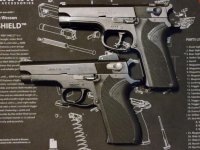When S&W changed over to using MIM for many of the smaller assemblies, they used stainless MIM and applied a black finish to it (not blued).
BTW, if you don't mind me asking, when you disassembled your manual safety assemblies, did you make sure the different plungers and springs didn't get mixed up during reassembly?
The reason I ask is that if the springs for the body plunger and the ambi lever plunger get switched, the lever spring won't be strong enough to prevent the mass of the manual safety assembly from moving under recoil and cycling. This typically means a pistol with switched springs can start 'decocking itself' and remaining On-Safe when fired.
Of course, a hint will be that trying to stuff the body plunger spring under the ambi lever is really difficult, because the spring is a lot heavier than the light ambi lever spring.
If the plungers are mixed up, the lever might not remain firmly captured by the plunger, and the decocking may feel very rough. The heads of the body plunger and ambi lever plunger are different. The body plunger must be the round-headed plunger. There was a transitional plunger in the older 3rd gen guns that could be mistaken for the body plunger if an armorer wasn't paying attention.
In this pic the Body plunger (fully rounded head) is on the bottom, and the ambi lever plunger is the middle one. The top one was originally the .45 ambi lever plunger, and eventually became the standard ambi lever plunger for 9/.40 guns, too. (The size of the plunger head requires a different lever, to fit the wide head.)


You can see how a quick glance might mistake the ambi lever plunger for the older body plunger.

When new, the lever spring would be painted light blue, and the body plunger is unpainted. Another clue is that the ambi lever spring is light enough in tension that it can be easily compressed between thumb and finger, but the body plunger spring will want to punch holes in your skin.


Sorry to post such trivia that may already be known to you, but I've seen some lesser experienced armorers make the mistake of switching either the springs, or the plungers, or both springs & plungers, at the bench without realizing it.
A friend of mine at another agency (head armorer) had one of his newly minted armorers mistakenly do that to a number of their 4006's once, during an inspection. It wasn't noticed until the next qualification quarter ... when those 4006's started decocking themselves with each shot and remaining in the On-Safe/decocked position.

Lucky there hadn't been any shooting incidents in the meantime, huh?









